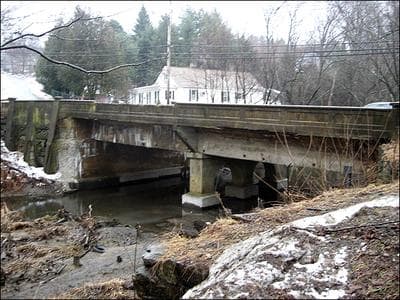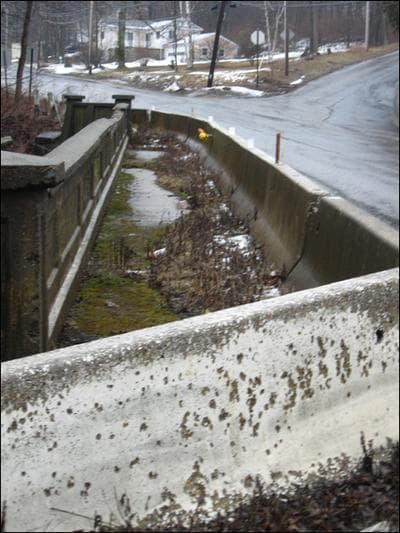Advertisement
Clinton Hopes To Use Stimulus To Rebuild A Vital Bridge

The Nashua River is at the heart of Clinton. It was key to the town’s prosperity during the Industrial Revolution as mills grew up alongside it. When the Wachusett Dam was built across the river, the waters of its reservoir flooded 40 percent of the town’s land.
“Construction started in 1892 and was fully completed in 1904,” says state Rep. Harold Naughton.
Driving by the dam, Naughton describes how construction of the dam dramatically affected the history of the town.
“You had German engineers and Italian skilled stone cutters” he says, “and there are still many Italian families that went into construction and started construction companies after that. Irish and Polish were the laborers, because they didn’t have steam shovels and things like that. They hauled these bricks and these rock on their back.”
The Nashua River cuts through this town whose streets negotiate the landscape of hills and ravines it’s carved out. Now, the town is looking for a little economic stimulus from the two-lane Water Street Bridge that has spanned the river for 80 years.
The bridge was never meant to last so long. Three years ago, it was designated as being in serious condition, meaning it could collapse.
“Without the bridge,” Naughton says, “half the town would be cut off, would have to take a much longer route into the downtown area.”
Clinton thrived during the Industrial Revolution, but because the town lies beyond Route 495, in the decades since World War II, it’s stagnated. Naughton hopes that by providing a better connection to the highway, a renovated bridge can revitalize the town’s sprawling and largely abandoned mills.
“We are eight miles from Route 495 here,” Naughton says, “and that eight miles has been like the great wall of China, because it’s limited industry coming into the town, trailer trucks, etcetera, and hopefully, this bridge restructuring might do something in that aspect to let transportation companies and the industry that they could bring come back into the town.”

Town officials say without the federal money, the bridge will have to be closed. It’s the town’s responsibility to rebuild the bridge, but the town doesn’t have the money.
Clinton’s superintendent of public works, Chris McGown, has been trying to figure out how to save the bridge.
“You can see that one sidewalk is closed completely,” McGown says. “The other side we actually have steel plates because there are sections of the deck that are actually completely missing.”
McGown points to a steel column, anchored in a concrete footing in the riverbed, that holds up one of the beams.
“Underneath the abutment,” McGown says, “they were afraid that the beam would actually collapse, so instead of closing the bridge, we did some temporary repairs to keep it open, ’cause it’s critical to us to keep this bridge open.”
Critical, for instance, to Clinton’s firefighters. Chief Richard Hart worries that without the bridge, it would take twice as long for fire trucks to get to the other side of the river.
“The response times would be significantly increased,” Hart says. “Somewhere from an area of three or four miles at present, to eight or nine miles to travel to get to the homes on the east side of the bridge.”
Reconstruction of the bridge couldn’t come soon enough to the parents picking up their children at the Clinton Elementary School. Parents such as Tina Grabiec, who uses the bridge every day.
“At least 20 times,” Grabiec says. “I got three kids. I travel. So, I’m constantly using that bridge, 24/7.”
“It’s an experience, I’ll tell you,” says Carol Martin, who is picking up her grandson. Martin says driving across the bridge makes for a harrowing ride.
“You pray your wheels don’t flat, your tires rather, or lose a part of your car,” she says.
The Massachusetts Highway Department has begun asking for bids for construction projects this month. Town officials in Clinton have been told the bridge will be among the first stimulus projects. But state officials say that Secretary of Transportation Jim Aloisi has yet to make the final decision.
Clinton’s state Rep. Harold Naughton, says legislators have influence in steering money to their towns.
“We advocate,” he says. “Statutorily, the stimulus legislation that came out of the Congress doesn’t give legislatures really any say. So it’s all advocacy: Advocate to the governor and to the governor’s administration about the needs of my district. It’s more persuasive authority that we have, and the governor’s been very open and very accessible for us to get in and advocate to his administration.”
Clinton’s town administrator, Michael Ward, compares the importance of the bridge project with those that were built during the Great Depression.
“We have had some wonderful structures here in Clinton from the WPA days that are still standing,” Ward says, “structures that we’d never be able to do on our own, and this is another example of that. I think that what this stimulus bill will try and do is try and get a lot of these major public works projects out there, and they’ll last nearly forever if they’re done right.”
The state estimates that public transportation and road and bridge projects will create more than 2,000 jobs this year. It projects that the $3.4 million it would spend to rebuild the bridge in Clinton would create 47 jobs, though it adds that there are no guarantees as to how many jobs each project will create.
Secretary of Economic Development Greg Bialecki explains that how many people you think you’ll put to work depends on what kind of work you count.
“You can either count the number of people who are literally working on the bridge,” Bialecki says, “or you can count the number of people who will be put to work, including the folks who are working at the suppliers for the materials for the bridge.”
Town officials don’t think that many people will actually end up working on the bridge. Clinton’s superintendent of public works isn’t counting the people who make the steel and make the concrete, but he predicts that by the time construction begins, there won’t be more than five to 20 people on the bridge.
This program aired on April 13, 2009. The audio for this program is not available.
